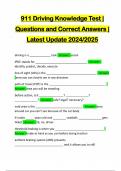Samenvatting
Summary required readings and articles - Customer Models RUG - MADS
- Instelling
- Rijksuniversiteit Groningen (RuG)
Summary of the required readings and articles for the course customer models at the university of Groningen: - Modeling markets by Leeflang et al. (2015): Chapter 1, 2, 8 (p.261-278, 285-288), 9 (p.322-325) - Advanced individual demand models by Fok (2017) - A logit model of brand choice calibra...
[Meer zien]













